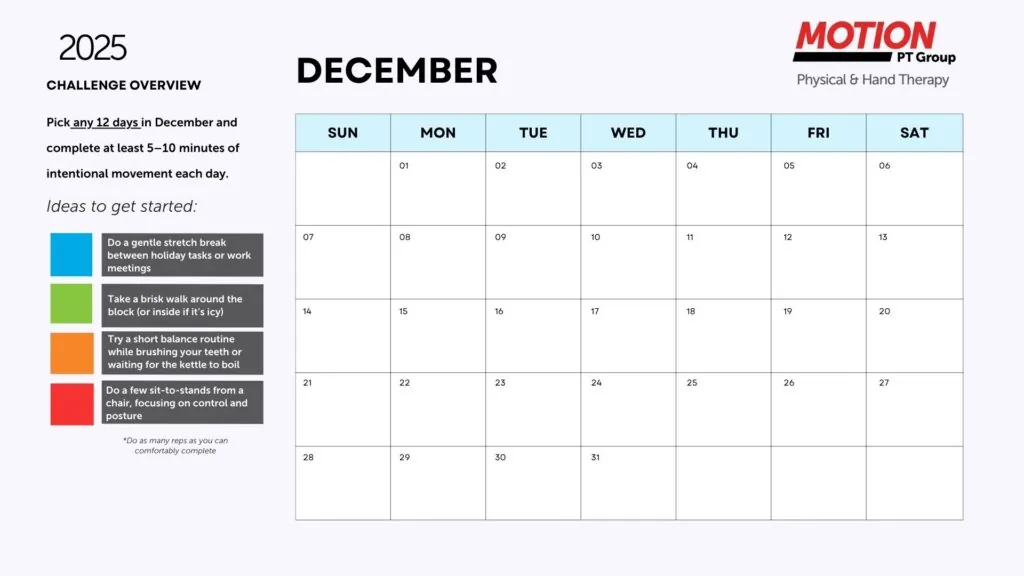With Men’s Health Week just around the corner, it’s an excellent time to shine a light on some of the unique health challenges men face and discuss how physical therapy can play a crucial role in addressing these issues. At MOTION, our therapists have noticed several injuries that tend to be more prevalent among men. Understanding these injuries and knowing how to prevent and treat them can significantly enhance quality of life.
Back Pain: The Epidemic of the Modern Man
Back pain is perhaps the most common complaint among my male patients. Whether due to strenuous physical activity, poor posture, or the demands of a physically intense job, back pain can be debilitating.
- Prevention and Treatment:
- Core Strengthening: Exercises that strengthen the core muscles can provide better support for the spine.
- Posture Training: Learning proper posture techniques, both in everyday activities and during exercise, can prevent strain.
- Manual Therapy: Techniques such as spinal manipulation and mobilization can provide relief and improve function.
Shoulder Injuries: The Result of Overuse and Strain
Shoulder injuries, including rotator cuff tears, tendinitis, and impingement syndrome, are common, especially among men who engage in activities like weightlifting, throwing sports, or repetitive overhead motions.
- Prevention and Treatment:
- Strengthening and Stretching: A balanced exercise regimen that includes strengthening the shoulder muscles and improving flexibility can prevent injury.
- Activity Modification: Adjusting techniques and reducing the frequency of high-risk activities can minimize strain.
- Physical Therapy Exercises: Specific exercises aimed at improving the range of motion and strengthening the shoulder complex are vital.
Knee Injuries: From Sports to Daily Life
Men are often involved in high-impact sports and activities that put significant stress on the knees, leading to injuries like ACL tears, meniscus tears, and patellar tendinitis.
- Prevention and Treatment:
- Strength Training: Focused exercises to strengthen the muscles around the knee can provide better joint stability.
- Proper Technique: Ensuring proper form during sports and exercises can prevent undue stress on the knees.
- Rehabilitation Exercises: A structured rehab program can help restore function and prevent future injuries.
Ankle Sprains: The Unexpected Turn
Ankle sprains are incredibly common, particularly among men who play sports involving running and jumping. These injuries, if not properly treated, can lead to chronic instability.
- Prevention and Treatment:
- Balance Training: Exercises that improve balance and proprioception can reduce the risk of ankle sprains.
- Supportive Footwear: Wearing appropriate shoes that provide adequate support can prevent injuries.
- Rehabilitation: After an injury, guided exercises to restore strength and flexibility are essential to prevent re-injury.
Overuse Injuries: The Slow Burn
Overuse injuries like tennis elbow (lateral epicondylitis), golfer’s elbow (medial epicondylitis), and shin splints are common in men who engage in repetitive activities, whether at work or play.
- Prevention and Treatment:
- Ergonomic Adjustments: Ensuring that workstations and sports techniques are ergonomically sound can prevent these injuries.
- Gradual Progression: Increasing activity levels gradually rather than abruptly can help avoid overuse injuries.
- Rest and Recovery: Allowing adequate time for rest and incorporating recovery strategies such as stretching and low-impact activities are key.
The Role of Physical Therapy in Men’s Health
Physical therapy is not just about treating injuries; it’s about preventing them and promoting overall health and well-being. During Men’s Health Week, we encourage all men to take proactive steps towards maintaining their health. Regular physical activity, balanced nutrition, and mindful practices can make a significant difference.
If you’re experiencing any of the injuries mentioned above or want to take steps to prevent them, consider scheduling a consultation with a physical therapist. Together, we can create a personalized plan that suits your lifestyle and goals.




